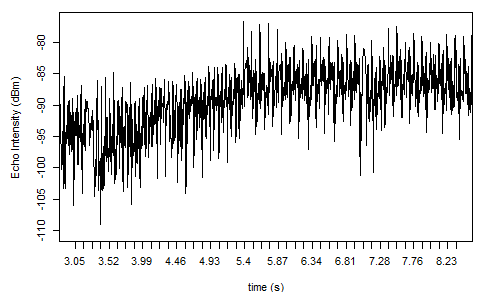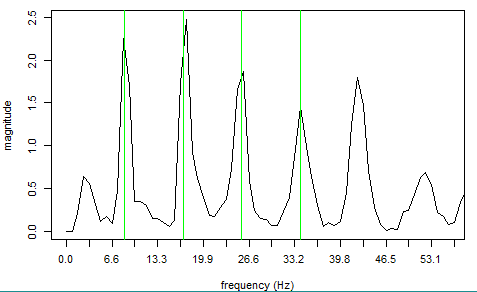BirdScan MV1
Adaptive wind park managment
The monitoring system allows the adaptive management of wind parks to mitigate collisions of migratory birds and bats with wind turbines. If the collision risk exceeds the specified threshold, the system alarms the plant operator or can automatically communicate with the wind park controls.
General description
BirdScan MV1 is a compact radar system for the continuous monitoring and risk management in wind farms. It uses a vertically directed conically shaped wide aperture beam to collect a rich set of information of the biomass in the sky. It does automatic real time quantification and classification that is used in the adaptive management algorithm to compute the collision risk, considering also environmental conditions like visibility and wind speed.

Comparison to traditional bird-radars
Traditional horizontally or vertically rotating bird-radars only illuminate a target for a fraction of second and wing-flapping pattern cannot be recorded. Therefore non-bird echos like insects cannot be properly excluded. In traditional rotating radars the surveyed volume is generally not well-defined and therefore computation of MTR is problematic.

Example of echo from a bird recorded system

The wing-flapping pattern is recorded and can be extracted automatically, here a continuously flapping bird with 8 wing-beats per second.
Placement
Wind turbines
The MR1 radar can be placed as close as 150 m to a turbine with a height of 90 m (hub height + rotor radius). Like for any radar, a rotating blade within the measurement range would produce strong disturbances and would make it hard to properly detect all birds. Generally, it is advisable to keep a distance of at least twice the height of the windturbine.
Offshore deployment
The offshore version of the BirdScan MR1 replaces some components with more robust parts in order to withstand offshore conditions. This version can be deployed offshore on a platform.
High quality offline-analytics
The BirdScan radar systems can reliably detect even small passerines, bats and insects. Hundreds of thousands echos per month can be recorded. To leverage the full potential of this data, detailed off-line analytic can be performed.
Product Specification
| Features and functionality | Details |
| usage | adaptive management |
| area of application | risk mitigation, continuous long term monitoring |
| sensing technology | pulse radar |
| antenna system | corrugated horn (rotating) |
| transmitter frequency | x-band fixed |
| transmitting power | 25 kW peak |
| range (height) | 750 m |
| resolution in space | 10 m |
| shutdown algorithm based on: | – spatiotemporal distribution – classification – mean traffic rate – environmental conditions |
| raw data | available for offline analyses |
| mean traffic rate | selectable heights |
| raw data | available for offline analyses |
| operation | automatic 24 h |
| electrical connection | 1x230V 400W |
| communication | LAN / WAN / GPRS |
| weight | Approx. 100 kg |
| environmental design | MIL STD 810 F |
| climate kit (optional) | HVAC, 1x230V 700W, 30kg |
| offshore kit (optional) | available |
MR1 / MV1 Publications
Cecilia Nilsson, Adriaan M. Dokter, Baptiste Schmid, Martina Scacco, Liesbeth Verlinden, Johan Bäckman, Günther Haase, Giacomo Dell’Omo, Jason W. Chapman, Hidde Leijnse, Felix Liechti (2018)
Field validation of radar systems for monitoring bird migration
Journal of Applied Ecology; 2018;00:1–13.
https://doi.org/10.1111/1365-2664.13174
Silvia Giuntini, Juha Saari, Adriano Martinoli, Damiano G. Preatoni, Birgen Haest, Baptiste Schmid, Nadja Weisshaupt (2024)
Quantifying nocturnal thrush migration using sensor data fusion between acoustics and vertical-looking radar
Birgen Haest, Felix Liechti, Will L. Hawkes, Jason Chapman, Susanne Akesson, Judy Shamoun-Baranes, Anna P. Nesterova, Vincent Comor, Damiano Preatoni and Silke Bauer (2024)
Continental-scale patterns in diel flight timing of high-altitude migratory insects
Simon Hirschhofer, Felix Liechti, Peter Ranacher, Robert Weibel, Baptiste Schmid (2024)
High-intensity bird migration along Alpine valleys calls for protective measures against anthropogenically induced avian mortality
Silke Bauer, Elske K. Tielens and Birgen Haest (2024)
Monitoring aerial insect biodiversity: a radar perspective
Yuval Werber, Hadar Sextin, Yossi Yovel, Nir Sapir (2023)
BATScan: A radar classification tool reveals large-scale bat migration patterns
Knop, E., Grimm, M.L., Korner-Nievergelt, F. et al. (2023)
Patterns of high-flying insect abundance are shaped by landscape type and abiotic conditions.
Giuntini S, Tattoni C, Gagliardi A, Martinoli A, Patocchi N, Lardelli R, et al. (2022)
Limnology for the ornithologist: effects of Lake Maggiore water level on migratory flows.
Shi, X.; Schmid, B.; Tschanz,P.; Segelbacher, G.; Liechti, F. (2021)
Seasonal Trends in Movement Patterns of Birds and Insects Aloft Simultaneously
Tschanz, P.; Pellissier, L.; Shi, X.; Liechti, F.; Schmid, B. (2020)
Consistency of spatio-temporal patterns of avian migration across the Swiss lowlands
Liechti, F., Aschwanden, J., Blew, J., Boos, M., Brabant, R., Dokter, A. M., Kosarev, V., Lukach, M., Maruri, M., Reyniers, M., Schekler, I., Schmaljohann, H., Schmid, B., Weisshaupt, N. and Sapir, N. (2019)
Crosscalibration of different radar systems for monitoring nocturnal bird migration across Europe and the Near East
https://doi.org/10.1111/ecog.04041
Baptiste Schmid, Serge Zaugg, Stephen C. Votier, Jason W. Chapman, Mathieu Boos and Felix Liechti (2019)
Size matters in quantitative radar monitoring of animal migration: estimating monitored volume from wingbeat frequency
Matthias Schmidt, Janine Aschwanden, Felix Liechti, Gábor Wichmann, Erwin Nemeth (2017)
Comparison of visual bird migration counts with radar estimates
Serge Zaugg, Gilbert Saporta, Emiel van Loon, Heiko Schmaljohann and Felix Liechti (2008)
Automatic identification of bird targets with radar via patterns produced by wing flapping
Are you looking for a radar solution?
Tell us about your project. We are looking forward to hearing from you.
